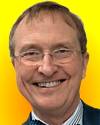
Born 22 Aug 1941; died 25 Dec 2021 at age 80. quotes
Thomas Eugene Lovejoy was an American biologist and conservationist who played a central role in the establishment of conservation biology, and has been called the “Godfather of Biodiversity.” Lovejoy was an early advocate for the preservation of the Amazonian rain forest. He has been an administrator at the Smithsonian Institution for environmental affairs, then chief biodiversity advisor to the World Bank among other influential positions. In the Amazon, for 20 years he ran a large-scale experiment he initiated in conservation biology, known as the known as the Minimum Critical Size of Ecosystems (MCSE) Project. It was a field test to scientifically determine whether the optimal conservation strategy favored a single large piece of land or preserving a large number of smaller plots.«
Thomas Eugene Lovejoy was an American biologist and conservationist who played a central role in the establishment of conservation biology, and has been called the “Godfather of Biodiversity.” Lovejoy was an early advocate for the preservation of the Amazonian rain forest. He has been an administrator at the Smithsonian Institution for environmental affairs, then chief biodiversity advisor to the World Bank among other influential positions. In the Amazon, for 20 years he ran a large-scale experiment he initiated in conservation biology, known as the known as the Minimum Critical Size of Ecosystems (MCSE) Project. It was a field test to scientifically determine whether the optimal conservation strategy favored a single large piece of land or preserving a large number of smaller plots.«
Environmental Profiles: A Global Guide to Projects and People, by Linda S. Katz, et al., eds. - book suggestion.
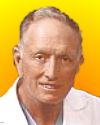
Born 22 Aug 1920; died 18 Nov 2016 at age 96. quotes
Dr. Denton A(rthur) Cooley is an American surgeon and heart-transplant pioneer who was the first to implant an artificial heart in a human. In 1960s he performed delicate surgery on the hearts of infants with congenital heart disease, and was the first surgeon to successfully remove pulmonary embolisms. On 3 May 1968, Cooley performed his first human heart transplant. On 4 Apr 1969, because no donor heart was available for a dying 47-year-old patient with diseased heart muscle, he implanted a mechanical heart made of silicone as a temporary measure. The experimental artificial heart was used for 65 hours, and was removed when a human heart became available.«
Dr. Denton A(rthur) Cooley is an American surgeon and heart-transplant pioneer who was the first to implant an artificial heart in a human. In 1960s he performed delicate surgery on the hearts of infants with congenital heart disease, and was the first surgeon to successfully remove pulmonary embolisms. On 3 May 1968, Cooley performed his first human heart transplant. On 4 Apr 1969, because no donor heart was available for a dying 47-year-old patient with diseased heart muscle, he implanted a mechanical heart made of silicone as a temporary measure. The experimental artificial heart was used for 65 hours, and was removed when a human heart became available.«
100,000 Hearts: A Surgeon's Memoir, by Denton A. Cooley. - book suggestion.
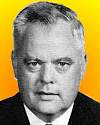
Born 22 Aug 1915; died 15 Jan 2007 at age 91.
Canadian-American physicist who was a pioneering researcher for the electron microscope. With Albert Prebus, he built the first successful electron microscope in North America (1939-40) The 41 patents he held included innovations in electron diffraction, ultra-thin sectioning and bacteriological techniques. To image such materials as blood cells or bacteria without destroying them with the electron beam, Hillier and others developed methods of preparation using a colloid film to protect samples. He worked for RCA from 1940 for 37 years. He continued to improve the design, and marketed the electron microscope to research institutions worldwide. In 1958, he became the director of the company's research laboratories at Princeton. By the 1960s, when RCA ended its manufacture of electron microscopes, about 2,000 had been sold.«
Canadian-American physicist who was a pioneering researcher for the electron microscope. With Albert Prebus, he built the first successful electron microscope in North America (1939-40) The 41 patents he held included innovations in electron diffraction, ultra-thin sectioning and bacteriological techniques. To image such materials as blood cells or bacteria without destroying them with the electron beam, Hillier and others developed methods of preparation using a colloid film to protect samples. He worked for RCA from 1940 for 37 years. He continued to improve the design, and marketed the electron microscope to research institutions worldwide. In 1958, he became the director of the company's research laboratories at Princeton. By the 1960s, when RCA ended its manufacture of electron microscopes, about 2,000 had been sold.«
Born 22 Aug 1907; died 21 Nov 2000 at age 93. quotes
Cyril Astley Clark was an English geneticist whose hobby cross-breeding butterflies, caused a curiosity about the genetically resulting wing color patterns. He realized there were parallels with inheritance of human blood types. This led to discoveries by him and others that eventually thwarted the Rh disease of newborn babies. The rhesus hemolytic disease could result in a fatal anemia in the baby born of a positive-Rhesus-factor father and a negative-Rhesus-factor mother. This disorder caused the women with Rh-negative blood to produce antibodies to the blood of their Rh-positive babies. At least 10,000 yearly in the U.S. resulted in severe brain damage or stillbirths. Knowing the cause, enabled more research to save newborns. This was one of the triumphs of preventative medicine.«
Cyril Astley Clark was an English geneticist whose hobby cross-breeding butterflies, caused a curiosity about the genetically resulting wing color patterns. He realized there were parallels with inheritance of human blood types. This led to discoveries by him and others that eventually thwarted the Rh disease of newborn babies. The rhesus hemolytic disease could result in a fatal anemia in the baby born of a positive-Rhesus-factor father and a negative-Rhesus-factor mother. This disorder caused the women with Rh-negative blood to produce antibodies to the blood of their Rh-positive babies. At least 10,000 yearly in the U.S. resulted in severe brain damage or stillbirths. Knowing the cause, enabled more research to save newborns. This was one of the triumphs of preventative medicine.«
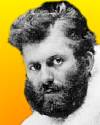
Born 22 Aug 1896; died 21 Jun 1995 at age 98.
Laurence McKinley Gould was an American explorer and geologist who was the first geologist to reach the interior of the Antarctic continent. He travelled to the Queen Maud Mountains, making geological and glaciological surveys. This involved a 2½-month, 1,500-mile dog-sledge journey that left on 4 Nov 1929. In that month, his party climbed Mount Fridtjof Nansen. Gould found layers of sandstone outcrops at the mountain's peak that showed Antartica's geological links with other continents. Gould's name is on several features on the map of Antarctica. Earlier, in 1926 Gould travelled to the Arctic as an expedition geologist. He was second in command on Admiral Byrd's 1929 South Pole expedition.«
Laurence McKinley Gould was an American explorer and geologist who was the first geologist to reach the interior of the Antarctic continent. He travelled to the Queen Maud Mountains, making geological and glaciological surveys. This involved a 2½-month, 1,500-mile dog-sledge journey that left on 4 Nov 1929. In that month, his party climbed Mount Fridtjof Nansen. Gould found layers of sandstone outcrops at the mountain's peak that showed Antartica's geological links with other continents. Gould's name is on several features on the map of Antarctica. Earlier, in 1926 Gould travelled to the Arctic as an expedition geologist. He was second in command on Admiral Byrd's 1929 South Pole expedition.«
Cold: The Record of an Arctic Sledge Journey, by Laurence M. Gould. - book suggestion.
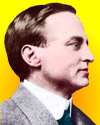
Born 22 Aug 1868; died 9 Jan 1958 at age 89. quotes
Willis Rodney Whitney was an American chemist and research director who founded the General Electric Company's research laboratory and directed pioneering work there. He is known as the “father of basic research in industry” because it became a model for industrial scientific laboratories elsewhere in the U.S. In Oct 1900 he was offered a research position at the General Electric (GE) Co., Schenectady, N.Y. His self-directed research program there began on a basis of three days a week. He quickly proved that chemical research techniques (such as use of an electric furnace) could be highly useful in the electrical industry. By 1904 he was directing 41 staff. His own 40 patents included the GEM lamp filament (1904), but contributed indirectly to many inventions. more
Willis Rodney Whitney was an American chemist and research director who founded the General Electric Company's research laboratory and directed pioneering work there. He is known as the “father of basic research in industry” because it became a model for industrial scientific laboratories elsewhere in the U.S. In Oct 1900 he was offered a research position at the General Electric (GE) Co., Schenectady, N.Y. His self-directed research program there began on a basis of three days a week. He quickly proved that chemical research techniques (such as use of an electric furnace) could be highly useful in the electrical industry. By 1904 he was directing 41 staff. His own 40 patents included the GEM lamp filament (1904), but contributed indirectly to many inventions. more
Willis R. Whitney, General Electric and the Origins of U.S. Industrial Research, by George Wise. - book suggestion.
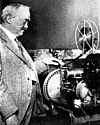
Born 22 Aug 1867; died 5 Jun 1934 at age 66.
American inventor of an altimeter, automobile self-starter, and a cone-shaped drinking cup, but known especially as an early television pioneer. In May 1920, at the Toronto meeting of the Society of Motion Picture Engineers, Jenkins introduced his "prismatic rings" as a device to replace the shutter on a film projector. This invention laid the foundation for his first radiovision broadcast. He claimed to have transmitted the earliest moving silhouette images on 14 Jun 1923, but his first public demonstration of these did not take place until Jun 1925. Jenkins Laboratories constructed a radiovision transmitter, W3XK, in Washington D.C. The short-wave station began transmitting radiomovies across the Eastern U.S. on a regular basis by 2 Jul 1928.
American inventor of an altimeter, automobile self-starter, and a cone-shaped drinking cup, but known especially as an early television pioneer. In May 1920, at the Toronto meeting of the Society of Motion Picture Engineers, Jenkins introduced his "prismatic rings" as a device to replace the shutter on a film projector. This invention laid the foundation for his first radiovision broadcast. He claimed to have transmitted the earliest moving silhouette images on 14 Jun 1923, but his first public demonstration of these did not take place until Jun 1925. Jenkins Laboratories constructed a radiovision transmitter, W3XK, in Washington D.C. The short-wave station began transmitting radiomovies across the Eastern U.S. on a regular basis by 2 Jul 1928.
Born 22 Aug 1860; died 24 Aug 1940 at age 80.
German engineer who discovered television's scanning principle, in which the light intensities of small portions of an image are successively analyzed and transmitted. Nipkow's invented (1884) a rotating disk (Nipkow disk) with one or more spirals of apertures that passed successively across the picture to make a mechanically scanned television system.
German engineer who discovered television's scanning principle, in which the light intensities of small portions of an image are successively analyzed and transmitted. Nipkow's invented (1884) a rotating disk (Nipkow disk) with one or more spirals of apertures that passed successively across the picture to make a mechanically scanned television system.
Born 22 Aug 1844; died 30 Oct 1881 at age 37.
American explorer whose disastrous Arctic expedition gave evidence of a continuous ocean current across the polar regions.
American explorer whose disastrous Arctic expedition gave evidence of a continuous ocean current across the polar regions.
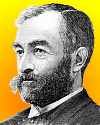
Born 22 Aug 1834; died 27 Feb 1906 at age 71. quotes
American astronomer, physicist and aeronaut who built the first heavier-than-air flying machine to achieve sustained flight. He launched his Aerodrome No.5 on 6 May 1896 using a spring-actuated catapult mounted on top of a houseboat on the Potomac River, near Quantico, Virginia. He also researched the relationship of solar phenomena to meteorology.« more
American astronomer, physicist and aeronaut who built the first heavier-than-air flying machine to achieve sustained flight. He launched his Aerodrome No.5 on 6 May 1896 using a spring-actuated catapult mounted on top of a houseboat on the Potomac River, near Quantico, Virginia. He also researched the relationship of solar phenomena to meteorology.« more
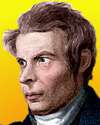
Born 22 Aug 1788; died 28 Jan 1829 at age 40. quotes
English railway engineer and writer who started as a cabinet-maker, then studied architecture and engineering, and by 1823 started private practice as a civil engineer. His book Elementary Principles of Carpentry (1820) was the first serious manual on the subject, including the strength of timber. He also wrote manuals on the Strength of Cast Iron (1821), extending the investigations of Thomas Young, heating of buildings, and The Steam Engine: its invention and progressive improvement. (1827). Five years before the first passenger train began service, his book on railways, Practical Treatise on Rail-Roads and Carriages (1825), also assessed the economic value of this 19th century breakthrough technology over that of canals and roads.«
English railway engineer and writer who started as a cabinet-maker, then studied architecture and engineering, and by 1823 started private practice as a civil engineer. His book Elementary Principles of Carpentry (1820) was the first serious manual on the subject, including the strength of timber. He also wrote manuals on the Strength of Cast Iron (1821), extending the investigations of Thomas Young, heating of buildings, and The Steam Engine: its invention and progressive improvement. (1827). Five years before the first passenger train began service, his book on railways, Practical Treatise on Rail-Roads and Carriages (1825), also assessed the economic value of this 19th century breakthrough technology over that of canals and roads.«
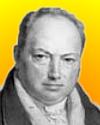
Born 22 Aug 1771; died 14 Feb 1831 at age 59. quotes
British engineer and inventor of the metal lathe and other devices. Maudslay was apprenticed to locksmith Joseph Bramah, and soon became his foreman. When he left to go into business for himself, Maudslay's first job was construction of machinery for the ship block (pulley) factory of Sir Marc Isambard Brunel. Through three decades during the Industrial Revolution, Maudslay invented various important machines, but of these the metal lathe particularly noteworthy. He also invented methods for printing calico cloth and for desalting seawater for ships' boilers. He perfected a measuring machine that was accurate to 0.0001 inch, and produced for his workshop accurate standard planes. more
British engineer and inventor of the metal lathe and other devices. Maudslay was apprenticed to locksmith Joseph Bramah, and soon became his foreman. When he left to go into business for himself, Maudslay's first job was construction of machinery for the ship block (pulley) factory of Sir Marc Isambard Brunel. Through three decades during the Industrial Revolution, Maudslay invented various important machines, but of these the metal lathe particularly noteworthy. He also invented methods for printing calico cloth and for desalting seawater for ships' boilers. He perfected a measuring machine that was accurate to 0.0001 inch, and produced for his workshop accurate standard planes. more
Henry Maudslay & the Pioneers of the Machine Age, by John Cantrell and Gillian Cookson (eds). - book suggestion.
Born 22 Aug 1647; died c. 1712. quotes
French-English physicist who invented the pressure cooker (1679). He assisted Dutch physicist Christiaan Huygens with air-pump experiments, and went to London in 1675 to work with the English physicist Robert Boyle. A few years later, Papin invented his steam digester (pressure cooker), a closed vessel with a tightly fitting lid that confined the steam at a higher pressure, considerably raising the boiling point of the water. A safety valve of his own invention prevented explosions. Observing that the enclosed steam in his cooker tended to raise the lid, Papin conceived of the use of steam to drive a piston in a cylinder, the basic design for early steam engines. He never built an engine of his own, but his idea was improved by others and led to the development of the steam engine, a major contribution to the Industrial Revolution.
French-English physicist who invented the pressure cooker (1679). He assisted Dutch physicist Christiaan Huygens with air-pump experiments, and went to London in 1675 to work with the English physicist Robert Boyle. A few years later, Papin invented his steam digester (pressure cooker), a closed vessel with a tightly fitting lid that confined the steam at a higher pressure, considerably raising the boiling point of the water. A safety valve of his own invention prevented explosions. Observing that the enclosed steam in his cooker tended to raise the lid, Papin conceived of the use of steam to drive a piston in a cylinder, the basic design for early steam engines. He never built an engine of his own, but his idea was improved by others and led to the development of the steam engine, a major contribution to the Industrial Revolution.
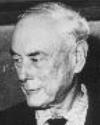
Died 22 Aug 1985 at age 97 (born 23 Jan 1888).
German physicist and crystallographer whose theory of X-ray interference by crystals was the first detailed, rigorous theoretical explanation of the diffraction effects first observed in 1912 by his fellow physicist Max von Laue.
German physicist and crystallographer whose theory of X-ray interference by crystals was the first detailed, rigorous theoretical explanation of the diffraction effects first observed in 1912 by his fellow physicist Max von Laue.
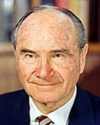
Died 22 Aug 1980 at age 81 (born 9 Apr 1899).
American aircraft manufacturer of aircraft. McDonnell started his first company in 1928, to build the single Doodlebug, but since it found no market, he spent the next 10 years working for several aircraft companies. Then he founded the St. Louis based McDonnell Aircraft Co.on 6 Jul 1939. Among his notable achievements were the production of the U.S. Navy's first carrier based jet fighter (1946), the FM-1; Mercury, America's first manned space craft to orbit the earth (1962), and the F-4 Phantom jet.
American aircraft manufacturer of aircraft. McDonnell started his first company in 1928, to build the single Doodlebug, but since it found no market, he spent the next 10 years working for several aircraft companies. Then he founded the St. Louis based McDonnell Aircraft Co.on 6 Jul 1939. Among his notable achievements were the production of the U.S. Navy's first carrier based jet fighter (1946), the FM-1; Mercury, America's first manned space craft to orbit the earth (1962), and the F-4 Phantom jet.
The Illustrated History of McDonnell Douglas Aircraft: From Cloudster to Boeing, by Mike Badrocke and Bill Gunston. - book suggestion.
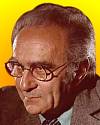
Died 22 Aug 1974 at age 66 (born 18 Jan 1908). quotes
Polish-British mathematician and science writer who eloquently presented the case for the humanistic aspects of science as the writer and presenter of the BBC television series, The Ascent of Man. Bronowski, who had a Ph.D. in algebraic geometry, spent WW II in Operations Research, and was an official observer of the after-effects of the Nagasaki and Hiroshima bombings. After this experience, he turned to biology, to better understand the nature of violence.«
Polish-British mathematician and science writer who eloquently presented the case for the humanistic aspects of science as the writer and presenter of the BBC television series, The Ascent of Man. Bronowski, who had a Ph.D. in algebraic geometry, spent WW II in Operations Research, and was an official observer of the after-effects of the Nagasaki and Hiroshima bombings. After this experience, he turned to biology, to better understand the nature of violence.«
The Ascent of Man, by Jacob Bronowski. - book suggestion.
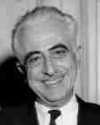
Died 22 Aug 1967 at age 64 (born 9 Apr 1903).
Gregory (Goodwin) Pincus was an American endocrinologist whose work on the antifertility properties of steroids led to the development of the first effective oral contraceptive: the birth-control pill. In 1934, Pincus made national headlines by achieving in-vitro fertilization of rabbits. The public was not ready for the vision of test-tube babies; instead of fame, he received notoriety. Consequently, he moved a small independent laboratory. There he did applied research, especially on steroids. In 1953, he was approached about developing a new form of contraception. He focussed on using progesterone as an effective anti-ovulent, and showed it could be a good contraceptive drug. In 1960, a synthetic progesterone drug was approved for contraceptive use.
Gregory (Goodwin) Pincus was an American endocrinologist whose work on the antifertility properties of steroids led to the development of the first effective oral contraceptive: the birth-control pill. In 1934, Pincus made national headlines by achieving in-vitro fertilization of rabbits. The public was not ready for the vision of test-tube babies; instead of fame, he received notoriety. Consequently, he moved a small independent laboratory. There he did applied research, especially on steroids. In 1953, he was approached about developing a new form of contraception. He focussed on using progesterone as an effective anti-ovulent, and showed it could be a good contraceptive drug. In 1960, a synthetic progesterone drug was approved for contraceptive use.
The Control of Fertility, by Gregory Pincus. - book suggestion.
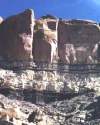
Died 22 Aug 1950 at age 62 (born 22 Jul 1888).
American geologist and geomorphologist who pioneered in explaining the forces that molded the present landforms of arid climates. Through his studies in hydrology, Bryan became an authority on the geology of water conservation and dam sites, and on several occasions served as consultant to the Mexican government on the construction of dams and reservoirs for reclamation projects. In 1923-25, Bryan served as geologist on archaeological expeditions in the Chaco Canyon area of New Mexico where he applied geological research as an aid to archaeological and anthropological investigation. His correlations of alluviums, cave deposits bearing artifacts, moraines, and till helped establish the antiquity of man in North America.
American geologist and geomorphologist who pioneered in explaining the forces that molded the present landforms of arid climates. Through his studies in hydrology, Bryan became an authority on the geology of water conservation and dam sites, and on several occasions served as consultant to the Mexican government on the construction of dams and reservoirs for reclamation projects. In 1923-25, Bryan served as geologist on archaeological expeditions in the Chaco Canyon area of New Mexico where he applied geological research as an aid to archaeological and anthropological investigation. His correlations of alluviums, cave deposits bearing artifacts, moraines, and till helped establish the antiquity of man in North America.
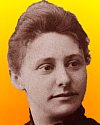
Died 22 Aug 1945 at age 87 (born 8 Sep 1857).
American physiologist who invented the microelectrode in the 1930's. This small device stimulates a living cell either chemically or electrically, and records the electrical activity within the cell. Her firsts include being the first woman to graduate from the University of Heidelberg (1896), to do research at the Harvard Medical School (in the Department of Physiology) and to be elected to the American Physiology Society. The microelectrode has been said to have revolutionized neurophysiology. She researched animal cardiac movement, circulation, respiration, and nervous systems. She investigated the breathing mechanism of the horseshoe crab and the grasshopper, and the respiratory center of the skate, amphibians, and mammals.
American physiologist who invented the microelectrode in the 1930's. This small device stimulates a living cell either chemically or electrically, and records the electrical activity within the cell. Her firsts include being the first woman to graduate from the University of Heidelberg (1896), to do research at the Harvard Medical School (in the Department of Physiology) and to be elected to the American Physiology Society. The microelectrode has been said to have revolutionized neurophysiology. She researched animal cardiac movement, circulation, respiration, and nervous systems. She investigated the breathing mechanism of the horseshoe crab and the grasshopper, and the respiratory center of the skate, amphibians, and mammals.
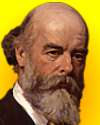
Died 22 Aug 1940 at age 89 (born 12 Jun 1851). quotes
English physicist who perfected his “coherer” to act as a radio-wave detector, the essential part of an early radiotelegraph receiver. On 14 Aug 1894, he made the first demonstration of wireless transmission of information using Morse code at a meeting of the British Association at Oxford. He transmitted a message about 150 yards from the old Clarendon Laboratory to the University Museum. He provided his laborary facilities to conduct the first clinical use of X-rays in England (7 Feb 1896), at the request of surgeon Sir Robert Jones (1855-1933), to examine the wrist of boy who had accidentally shot himself. Lodge invented electric spark ignition, and investigated psychic phenomena with his friend Sir Arthur Conan Doyle.« more
English physicist who perfected his “coherer” to act as a radio-wave detector, the essential part of an early radiotelegraph receiver. On 14 Aug 1894, he made the first demonstration of wireless transmission of information using Morse code at a meeting of the British Association at Oxford. He transmitted a message about 150 yards from the old Clarendon Laboratory to the University Museum. He provided his laborary facilities to conduct the first clinical use of X-rays in England (7 Feb 1896), at the request of surgeon Sir Robert Jones (1855-1933), to examine the wrist of boy who had accidentally shot himself. Lodge invented electric spark ignition, and investigated psychic phenomena with his friend Sir Arthur Conan Doyle.« more
Making of Man: A study in Evolution, by Oliver Joseph Lodge. - book suggestion.
Died 22 Aug 1866 (born 1797).
English pioneer of omnibuses. Having founded a coach-building enterprise in Paris (1825), he expanded to include buses. On 4 Jul 1829, he commenced the first regular bus service from London to Paddington, carrying up to 20 passengers and in a coach drawn by three horses. Shillibeer adopted the word omnibus. He boasted it offered a safer and more comfortable ride than ordinary stagecoaches, since all passengers would ride inside. He was followed by imitators then more competition from the discovery that a trolley running on tracks could pull twice the payload. Although Shillibeer had revolutionized London's transport, he went bankrupt and spent time in debtors' prison. He eventually converted his omnibuses into "Shillibeer's Funeral Coaches".
English pioneer of omnibuses. Having founded a coach-building enterprise in Paris (1825), he expanded to include buses. On 4 Jul 1829, he commenced the first regular bus service from London to Paddington, carrying up to 20 passengers and in a coach drawn by three horses. Shillibeer adopted the word omnibus. He boasted it offered a safer and more comfortable ride than ordinary stagecoaches, since all passengers would ride inside. He was followed by imitators then more competition from the discovery that a trolley running on tracks could pull twice the payload. Although Shillibeer had revolutionized London's transport, he went bankrupt and spent time in debtors' prison. He eventually converted his omnibuses into "Shillibeer's Funeral Coaches".
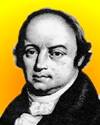
Died 22 Aug 1828 at age 70 (born 9 Mar 1758). quotes
German physician, anatomist and physiologistt who pioneered in linking cerebral functions to localized areas of the brain and associated with underlying attributes of the human personality. As early as the 1790s, he was developing theories on the anatomy and function of the parts of the brain. He was first to identify recognize that the brain's gray matter was made up of nerve cell bodies, and that the white matter has the fibers that carry impulses from the nerves. He believed an external examination of the skull could reveal individual intellect and personality, which he termed “cranioscopy,” later called “phrenology” by his protegé, Johann G. Spurzheim. In 1805, they travelled on a long lecture tour of Europe, also studying at prisons and asylums.«
German physician, anatomist and physiologistt who pioneered in linking cerebral functions to localized areas of the brain and associated with underlying attributes of the human personality. As early as the 1790s, he was developing theories on the anatomy and function of the parts of the brain. He was first to identify recognize that the brain's gray matter was made up of nerve cell bodies, and that the white matter has the fibers that carry impulses from the nerves. He believed an external examination of the skull could reveal individual intellect and personality, which he termed “cranioscopy,” later called “phrenology” by his protegé, Johann G. Spurzheim. In 1805, they travelled on a long lecture tour of Europe, also studying at prisons and asylums.«
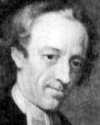
Died 22 Aug 1752 at age 84 (born 9 Dec 1667). quotes
English priest and mathematician who sought to harmonize religion and science, and who is remembered for reviving in England the heretical views of Arianism. He attended Newton's lectures while at Cambridge and showed great promise in mathematics. Ordained in 1693. While chaplain to the bishop of Norwich (1694-98), he wrote A New Theory of the Earth (1696), in which he claimed that the biblical stories of the creation, flood and final conflagration could be explained scientifically as descriptions of events with historical bases. The Flood, he believed, was caused by a comet passing close to the Earth on 28 Nov 2349 BC. This put stress on the Earth's crust, causing it to crack and allow the water to escape and flood the Earth. After serving as vicar of Lowestoft (1698–1701), he returned to his alma mater, Cambridge University to become assistant to the mathematician Sir Isaac Newton, whom he succeeded as professor in 1703.
English priest and mathematician who sought to harmonize religion and science, and who is remembered for reviving in England the heretical views of Arianism. He attended Newton's lectures while at Cambridge and showed great promise in mathematics. Ordained in 1693. While chaplain to the bishop of Norwich (1694-98), he wrote A New Theory of the Earth (1696), in which he claimed that the biblical stories of the creation, flood and final conflagration could be explained scientifically as descriptions of events with historical bases. The Flood, he believed, was caused by a comet passing close to the Earth on 28 Nov 2349 BC. This put stress on the Earth's crust, causing it to crack and allow the water to escape and flood the Earth. After serving as vicar of Lowestoft (1698–1701), he returned to his alma mater, Cambridge University to become assistant to the mathematician Sir Isaac Newton, whom he succeeded as professor in 1703.
William Whiston: Honest Newtonian, by James E. Force. - book suggestion.
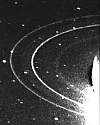
In 1989, the first complete ring around Neptune was discovered in photographs transmitted by Voyager 2 to the Jet Propulsion Laboratory in the U.S. Dusty debris was seen to form a tenuous but complete ring about 17,000 miles above Neptune's clouds. The material in the ring appeared be distributed uniformly through the dark circle, though whether fine or large particles was undetermined. The ring lies just outside the orbit of one of the planet's small moons, designated then as 1989 N3, also newly discovered by Voyager 2. Only arcs - fragments of rings around Neptune, had previously viewed from Earth-based observations, which were also shown as arcs in photographs taken by Voyager 2 eleven days earlier.«[Image: Part of a 591-second exposure of the rings of Neptune taken by Voyager 2 on 26 Aug 1989. Two main rings and and a fainter inner ring are visible. Neptune itself is to the right of this portion of the image, but has been cropped as it is greatly overexposed. A second exposure by Voyager (not included here) shows the rings circling around the other side of Neptune.]
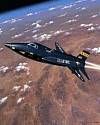
In 1963, the X-15 rocket plane achieved a world record altitude of 354,200 feet (107,960 m, 67 miles) with U.S. Air Force pilot Joseph A. Walker, flight 91 of the series of test flights. Its internal structure of titanium was covered with a skin of Inconel X, a chrome-nickel alloy. To save fuel, the X-15 was air launched from a B-52 aircraft at about 45,000 ft. Test flights between 8 Jun 1959 and 24 Oct 1968 provided data on hypersonic air flow, aerodynamic heating, control and stability at hypersonic speeds and piloting techniques for reentry used in the development of the Mercury, Gemini, and Apollo spaceflight programs.«[Image: NASA artist's conception of the flight.]
Hypersonic! The Story of the North American X-15, by Dennis R. Jenkins, Tony Landis. - book suggestion.
In 1962, The Savannah, the world's first nuclear-powered ship, completed her maiden voyage from Yorktown, Va., to Savannah, Ga.
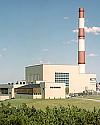
In 1950, the pile achieved criticality in the Brookhaven Graphite Research Reactor (BGRR), the world's first nuclear reactor dedicated to the peaceful applications of atomic energy. It was patterned after a successful reactor at Oak Ridge National Laboratory. The improved reactor design of the BGRR added facilities to accommodate research in medicine, biology, chemistry, physics and nuclear engineering. The reactor pile consisted of a 700-ton, 25-foot cube of graphite fueled by uranium, enclosed in a steel-lined, high-density, five-foot-thick concrete shield. A total of 1,369 fuel channels were available with roughly half in use at any given time. Reactor power was controlled by insertion and removal of boron steel control rods.«
Making Physics: A Biography of Brookhaven National Laboratory, 1946-1972, by Robert P. Crease. - book suggestion.
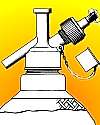
(USPTO)
In 1939, the first U.S. patent for dispensing liquids under pressure from a disposable container was issued to Julius Seth Kahn of New York City (No. 2,170,531). The patent was titled "Apparatus For Mixing a Liquid With a Gas," but was the predecessor of the aerosol spray can. In this case, the patent more particularly specified a use for whipping cream "by discharging the cream and gas mixture through a constricted orifice." The cream could be contained in a common soda-pop glass bottle. Gas could be introduced at controlled pressure. An inexpensive valve discharged the whipped cream. Its use was extended to applications such as dispensing paints, pharmaceuticals and insecticides.
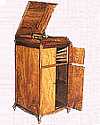
In 1906, the Victor Talking Machine Company of Camden, New Jersey, began to manufacture the Victrola record player. The hand cranked unit, with horn cabinet, sold for $200. Unlike previous phonographs, which were toy-like turntables with a large speaker horn to amplify the sound, this was housed in an elegant wood cabinet in several contemporary (for the time) furniture styles. The speaker horn and turntable mechanism were totally concealed, and there were convenient storage compartments for records thus transforming the phonograph into a popular household item, and setting the pattern of wood cabinetry enclosures later imitated by radios and television sets well into the 1950s.[Image: 1906 Victrola Model XVI]
In 1865, the first U.S. patent for a liquid soap was issued to William Sheppard of New York City (No. 49,561). The patent described his "discovery that by the addition of comparatively small quantities of common soap to a large quantity of spirits of ammonia or hartshorn is thickened to the consistency of molasses, and a liquid soap is obtained of superior detergent qualities." The proportions given were to dissolve one pound of common soap in water or steam, and then add 100-lbs of ammonia such that the liquid thickens to the consistency of molasses. The product was expected to be useful for both domestic and manufacturing purposes. (Hartshorn is an ancient name for an aqueous solution of ammonia).«*
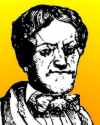
woodcut of Fitch
In 1787, inventor John Fitch demonstrated his steamboat on the Delaware River to delegates of the Continental Congress. Its top speed was 3 mph. These tests were completed years before Fulton built his steamboat. Early in 1787, the Colombian Magazine described the steam engine design as “similar to the late improved steam engines in Europe,” with a horizontal twelve-inch cylinder. The piston was proposed to give “thirty strokes in a minute; which will give the axle tree about forty revolutions. Each revolution of the axle tree moves twelve oars five and a half feet. As six oars come out of the water, six more enter the water... The oars work perpendicularly and make a stroke similar to the paddle of a canoe.”«




